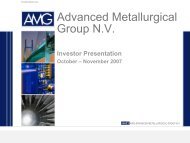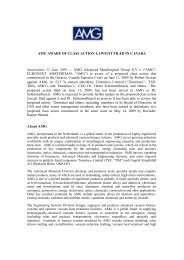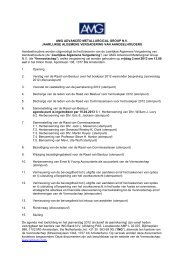C Si Ni Cr V Ti Ta Sc Li Sr Zr Fe Cu Zn Sn B Al Ce U Mn Mo Nb Sb
C Si Ni Cr V Ti Ta Sc Li Sr Zr Fe Cu Zn Sn B Al Ce U Mn Mo Nb Sb
C Si Ni Cr V Ti Ta Sc Li Sr Zr Fe Cu Zn Sn B Al Ce U Mn Mo Nb Sb
You also want an ePaper? Increase the reach of your titles
YUMPU automatically turns print PDFs into web optimized ePapers that Google loves.
Senior Leverage covenant to 3.00x. The Total Leverage<br />
covenant remained unchanged at 3.75x. AMG’s financing<br />
risk is also mitigated by its year-end 2010 liquidity of<br />
$137.1 million.<br />
Entrepreneurial Risk<br />
The continued growth of AMG’s business requires the<br />
development of new products and new production<br />
processes and highly capable management. Developing<br />
and investing in these products and processes involves<br />
the acceptance of certain measured entrepreneurial<br />
risks. As competitors duplicate successful technologies<br />
or develop new methodologies, AMG must continue to<br />
innovate in order to maintain leading positions in its<br />
strategic niches. It is particularly important to strike an<br />
appropriate balance between investments in innovation<br />
to secure future growth versus the need to preserve cash<br />
to withstand an economic crisis. For this reason, AMG<br />
management evaluates more than the projected internal<br />
rate of return or the discounted cash flows of a potential<br />
project. AMG also examines the consequences of declining<br />
projects and the possibility of lost cash flows from the<br />
inability to innovate. In addition to looking at the inherent<br />
risk on a project-by-project basis, AMG also evaluates<br />
the risk of a portfolio of projects being undertaken or<br />
developed in the pipeline. Evaluating a project within a<br />
portfolio of opportunities allows AMG to better manage<br />
its liquidity and capital allocation. While certain projects<br />
may be beneficial and profitable in the long run, timing of<br />
cash flows is critically important as AMG always seeks to<br />
maintain sufficient liquidity to operate its existing businesses.<br />
Managing entrepreneurial risk requires active<br />
management. Frequent Management Board meetings<br />
enable the senior executives of AMG to stay informed<br />
of all the latest information, allowing for quick action,<br />
further reducing risk. During 2010 AMG acquired <strong>Mo</strong>no2 solar casting technology from BP Solar International Inc.,<br />
allowing AMG’s Engineering Systems Division to offer<br />
an advanced integrated solar melting and crystallization<br />
technology. Acquisitions of new technology such as this<br />
will help AMG avoid entrepreneurial risk. AMG’s highly<br />
educated and skilled workforce contributes greatly to<br />
AMG’s entrepreneurial success. High employee turnover<br />
or loss to a competitor of key personnel, many of whom<br />
possess specific technical and manufacturing knowledge,<br />
is a risk to AMG. Many incentives, financial and other, are<br />
used to maintain a motivated workforce.<br />
<strong>Cu</strong>rrency Risk<br />
AMG’s largest currency risk exists where it incurs an<br />
imbalance in revenues and costs in a particular currency.<br />
While the single largest sensitivity of this nature exists<br />
for the Euro, risk also exists with the British Pound and<br />
Brazilian Real. AMG may enter into currency hedges to<br />
mitigate this risk. AMG also faces currency risk when it<br />
enters into a fixed price contract to sell a product in one<br />
currency while the costs incurred are in an alternate<br />
currency. AMG typically enters into currency hedges to<br />
mitigate this currency timing risk.<br />
Legal and Regulatory Risk<br />
<strong>Li</strong>ke all companies, AMG is exposed to the changing<br />
regulatory environment in the countries and regions<br />
where it conducts business. The most notable changes<br />
are coming in the form of environmental policy and to a<br />
lesser extent governmental restrictions on the freedom<br />
to operate in certain countries and jurisdictions. New<br />
environmental regulations or a change in regulatory bodies<br />
that have jurisdiction over AMG products and facilities<br />
could result in new restrictions, including those relating<br />
to the storage or disposal of legacy material at AMG<br />
owned properties, which may result in significantly higher<br />
costs to AMG (see note 35 to the Consolidated Financial<br />
Statements). The environmental regulations that are<br />
important for the growth in AMG’s business, however, may<br />
present operational challenges to AMG’s manufacturing<br />
processes. <strong>Mo</strong>re stringent regulations may be enacted<br />
for the release of air emissions, wastewater discharge or<br />
solid waste, which may negatively impact AMG’s operations.<br />
Additionally, the REACH Directive became effective<br />
in the European Union in June 2007. REACH requires<br />
new operational procedures regarding the registration,<br />
evaluation and authorization of chemical substances.<br />
AMG’s business units have pre-registered all required<br />
materials and also made complete registrations for<br />
those products required in 2010 as a result of tonnage or<br />
hazardous properties. Plans are in place to meet 2013 and<br />
Report of the Management Board | Risk Management and Internal Controls 35







